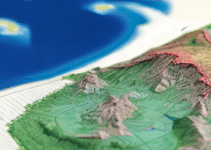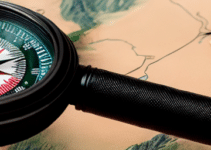Sure to have a physical copy of the map for emergency situations, as it will be vital in navigating emergencies and utilizing map navigation skills. While digital maps can be convenient, they may not always be accessible during emergencies, especially if there is a power outage or limited cell service.
Having a physical map as a backup is essential.
In emergency situations, time is often of the essence.
This is why it is crucial to practice using emergency maps before you actually need them. Familiarize yourself with the map's layout, and practice using it to navigate from point A to point B.
This can help build your confidence and efficiency when it truly matters. In addition to having a physical map, it can also be beneficial to master emergency map skills for navigating emergencies.
‘Click here to learn more about: ‘ patriot
Maps in Emergency Situations
Emergency situations can be chaotic and overwhelming, making the usage of maps in emergencies crucial for emergency navigation and disaster response. Maps serve as valuable tools by providing vital information to help responders and affected individuals navigate through challenging circumstances.
They play a vital role in emergency planning, disaster response, and navigation, ensuring the safety and well-being of everyone involved.
Additionally, emergency mapping techniques, such as real-time data integration, enhance the effectiveness of maps in these situations.
It is important to prioritize accurate and up-to-date maps that are easily accessible to all, regardless of technological capabilities, to ensure everyone has access to the necessary information during emergencies
Essential Map Reading Skills for Emergencies
In times of crisis and emergency, having the necessary map reading skills, particularly map usage during emergencies, can truly make a difference in one's survival and safety. When faced with unexpected situations, the ability to navigate using maps becomes not just helpful, but essential.
This comprehensive guide aims to equip you with the essential skills needed to effectively use maps during emergencies, ensuring that you can find your way even in the most chaotic and unpredictable scenarios.
To start, it is important to understand map symbols and legends.
These symbols and legends provide valuable information about the terrain, landmarks, and other important features. By familiarizing yourself with them, you'll be able to interpret maps more accurately and efficiently.
Another important skill is reading contour lines. Contour lines help depict the shape and elevation of the land on a map, allowing you to understand the emergency map routes and symbols, aiding in map reading during crisis situations.
Map Reading Skills
- Map reading skills are crucial for survival and safety during times of crisis and emergency.
- The ability to navigate using maps becomes essential in unexpected situations.
- Understanding map symbols and legends provides valuable information about the terrain and landmarks.
- Reading contour lines helps in understanding the shape and elevation of the land on a map, aiding in map reading during crisis situations.
Best Map Apps for Navigating during Emergencies
Finding the best map app for emergencies is a process that involves considering a few essential features, such as map orientation and accuracy, as well as the use of emergency map markers for search and rescue operations. One of the most important features to look for is offline functionality.
During times of crisis, when internet connectivity may be unreliable or unavailable, being able to download maps and access them offline is crucial.
These offline maps ensure that you can navigate and access vital information, even without an internet connection.
Another crucial feature to consider is real-time updates. In rapidly changing emergency situations, having a map app that provides real-time updates can be invaluable.
This includes features like live traffic updates, road closures, and emergency alerts. These real-time updates help you stay informed and make informed decisions on the go.
Some map apps go above and beyond by offering unique emergency-specific functionalities
Effective Emergency Planning with Maps
In addition to map visualizations for emergencies, maps can also be valuable for crowd management in emergencies by using maps for emergency transportation. By incorporating crowd density data into maps, emergency planners can gain a better understanding of and address potential bottlenecks or overcrowded areas.
This information is crucial for efficient resource allocation and ensuring the safety of individuals during evacuations or mass gatherings.
Maps facilitate emergency map coordination, enabling different response teams to communicate and coordinate their efforts effectively.
This collaboration significantly enhances the overall response and recovery process in emergency situations
Key Map Symbols for Crises
When it comes to navigating through natural disasters and other emergency situations, map navigation becomes essential for emergency evacuation routes and using maps for emergency communication systems. The use of key map symbols for crises provides invaluable assistance in emergency map plotting and enables efficient communication systems.
These symbols not only help with emergency notifications but also play a vital role in identifying evacuation routes.
By incorporating map tools for emergency management, responders and the general public can access crucial emergency map data.
This standardized approach ensures that everyone, regardless of language or cultural barriers, can effectively interpret and utilize these symbols during crises
Maps in Search and Rescue Operations
Streamlining communication and coordination between different agencies and organizations involved in search and rescue operations involves the use of maps for emergency information dissemination and map integration in emergency systems. These systems allow for the seamless sharing of information and resources, ensuring that everyone is on the same page and working towards a common goal.
By consolidating various maps and data sets onto a single platform, emergency map coordination systems enable efficient collaboration and decision-making.
Another significant advantage of using maps in search and rescue operations is their ability to provide a comprehensive overview of an area.
By combining aerial imagery, satellite imagery, and topographic data, these maps can give rescuers a detailed understanding of the terrain and potential hazards they may encounter. This information is crucial for planning and executing rescue missions safely and effectively.
Maps also assist in the navigation of search and rescue teams. GPS technology integrated into maps allows for precise positioning and tracking, ensuring that teams can locate their positions accurately, which is vital for emergency map planning and map integration in emergency systems.
Emergency Map Coordination Systems
- Emergency map coordination systems streamline communication and coordination between different agencies and organizations involved in search and rescue operations.
- These systems enable the seamless sharing of information and resources, ensuring efficient collaboration and decision-making.
- By consolidating various maps and data sets onto a single platform, emergency map coordination systems facilitate efficient collaboration and decision-making.
- Maps in search and rescue operations provide a comprehensive overview of an area by combining aerial imagery, satellite imagery, and topographic data.
- Maps assist in the navigation of search and rescue teams by integrating GPS technology for precise positioning and tracking.
- GPS technology integrated into maps allows for accurate location tracking, which is vital for emergency map planning and integration in emergency systems.
Maps in Emergency Evacuation Routes
During times of emergencies, the utilization of map visualization in emergency situations becomes invaluable for emergency relief efforts. These maps are crucial tools for coordinating emergency response and helping individuals navigate towards designated evacuation routes and safe zones.
In addition to their significance during the chaos of an emergency, maps also play a vital role in emergency operations centers.
They serve as an essential part of the overall emergency map infrastructure, aiding in emergency triage, efficient resource allocation, and the distribution of emergency supplies.
Overall, the visualization of maps in emergency situations is a key element in ensuring the safety and well-being of individuals during evacuations
Enhancing Communication and Coordination with Maps in Emergencies
When it comes to emergencies, using maps for emergency command centers is of utmost importance for ensuring the safety and well-being of individuals. In such critical situations, one tool that has proven to be invaluable is the use of emergency map technology.
These maps provide real-time updates by incorporating data from various sources such as weather forecasts, traffic conditions, and emergency service locations.
They offer a comprehensive view of the affected area, enabling emergency responders and stakeholders to quickly understand the situation and make informed decisions.
Emergency maps aid in identifying potential hazards, planning evacuation routes, and allocating resources efficiently. They also facilitate communication and collaboration among different stakeholders, ensuring that everyone involved is on the same page and working towards a common goal. Using maps for emergency management agencies can help visualize the impact of an emergency, overlaying data such as population density, infrastructure vulnerability, and critical facilities to prioritize efforts and allocate resources.
Emergency Map Technology
- Emergency map technology provides real-time updates during emergencies.
- These maps incorporate data from weather forecasts, traffic conditions, and emergency service locations.
- Emergency maps aid in identifying potential hazards and planning evacuation routes.
- Using maps for emergency management agencies helps visualize the impact of an emergency by overlaying data such as population density, infrastructure vulnerability, and critical facilities.
Essential Map Tools for Emergency Management
In the realm of emergency management, the use of maps in emergency drills is a critical component for effective preparedness, especially when utilizing map reading for emergency response teams to enhance situation awareness and using maps for emergency decision support systems. These drills simulate various emergency scenarios, allowing response teams to practice their skills and evaluate how well their plans align with the actual terrain.
By incorporating maps into these drills, emergency managers can assess the effectiveness of their strategies and identify areas for improvement.
The availability of emergency map apps for smartphones has made them indispensable tools for both responders and the public.
These apps provide real-time updates, enabling users to navigate through emergency situations with ease and access vital information about nearby safe zones, evacuation routes, and emergency service locations. The convenience and accessibility of these apps make them essential for individual preparedness and community resilience. Maps play a crucial role in emergency communication apps, providing vital information and aiding in map reading for emergency response teams.
Navigate Emergencies Essential Tools for Safety
Essential Survival Gear Navigate with Ease





